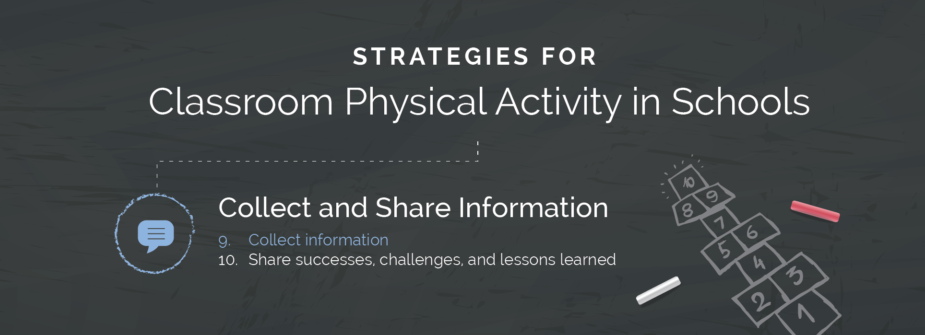Collect information on classroom physical activity.
Teachers, administrators, and physical activity champions can collect information on classroom physical activity efforts, and teachers can track the types of physical activities they use in their classroom. This information can include preparation time, ease of implementation, whether students enjoyed the activity, and length of the activity. Students also can track their activities in a day planner.
Teachers can assess the effect of physical activities on student behavior, such as whether students are focused, having fun learning, and exhibiting fewer off-task behaviors (like fidgeting, excessive talking, or gazing off). They also can assess the effect these activities have on students’ learning and academic performance (such as their grades and test scores). If resources allow, teachers can work with universities or other organizations to use pedometers or other wearable devices to measure student physical activity levels in the classroom.
Teachers can also anecdotally assess the overall learning environment—for example, by observing how the use of physical activity is helping them manage their classroom and how well students are interacting with each other and engaging in the lessons being taught. For students with an individualized education program or a 504 plan, schools can collect information about how classroom physical activity is supporting their progress in meeting identified education goals.
Citations can be found in Strategies for Classroom Physical Activity in Schools.
Key Activities
Put Strategy 9 into practice through the following activities:
✓ Identify what information can be feasibly collected on classroom physical activity efforts.
✓ Prioritize what information will be collected.
✓ Determine method and frequency of collection or documentation.
✓ Determine who will collect the information.
✓ Document information on classroom physical activity.
Questions for Consideration
Use the following questions to guide key activities and inspire new ideas:
– What is the purpose of collecting information for classroom physical activity (for example, explain or support your efforts, build buy-in, secure funding, and apply for awards programs)?
– What information will help address the identified purpose (for example, changes in test scores and anecdotes about the effect of classroom physical activity on student attention and behavior)?
– In addition to teachers, who else can help collect information (for example, students, staff, parents, and university researchers)?
– What templates or tools exist to help record the information collected?
– How can results be compiled at the school and district levels?
Resource
Information Collection and Sharing Planning Template
Use this template to to identify information of interest and methods of collection, as well as ways to share the information of interest and methods of communication.
Make the case for promising practices by collecting and sharing data – A story from Utah
Track data to build buy-in and sustainability – A story from Indiana
Information Collection and Sharing Planning Template (Springboard to Active Schools)
This template can be used to plan for “Strategy 9: Collect information on classroom physical activity” and “Strategy 10: Share successes, challenges, and lessons learned from classroom physical activity”. Use this template to to identify information of interest and methods of collection, as well as ways to share the information of interest and methods of communication.
Active Schools Toolkit (Wisconsin Department of Public Instruction, Toolkit)
Page 27-29 – Methods for measuring both processes and outcomes related to classroom physical activity.
Brain Breaks (HOPSports, Program)
This online platform allows teachers to collect “points” and track classroom physical activity.
Daily Physical Activity in Schools, Grades 1 to 3 (Ontario Ministry of Education, Guide)
Page 23 – Describes the importance of choosing which categories of achievement should be assessed, considerations for assessments, and tips.
After creating an account and signing in, this resource automatically tracks the number of minutes spent doing physical activity.
InPACT 2017: Compendium of Physical Activities (University of Michigan)
Pages 61-68 – Weekly and daily questionnaires related to physical activity for teachers, perceived stress and feeling scales for students, and instructions for calculating heart rate.
PLAY 60 Challenge Lesson Plans (American Heart Association, Lesson Plans)
Pages 19-20 – A year-round physical activity initiative maintenance evaluation template.

